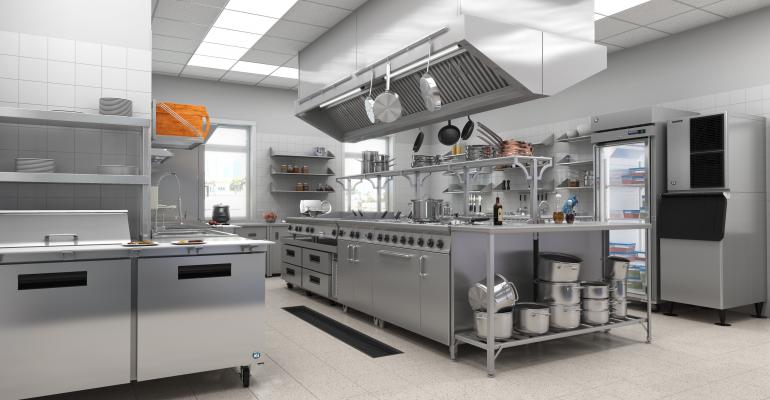Sponsored by Hoshizaki
From high-volume banquet operations to busy lunch eateries and “dark” delivery-only restaurants, pass-thru, roll-in and roll-thru refrigerators play an important role. They are versatile pieces of equipment that safely and efficiently cool food while saving vital space, steps and time in the kitchen.
All three types belong to the upright category of refrigeration equipment. Pass-thru refrigerators have doors on the front and back of the unit, enabling food and beverage items to be placed or removed from shelves on either side. They are mounted on casters for easy movement. They are available either with glass doors, typically chosen for customer-facing kitchens where esthetics are important, or with stainless-steel doors that can stand up to rough use in busy back-of-the-house settings.
Roll-in and roll-thru refrigerators are stationary pieces. Roll-in units have a single door, designed to hold a rolling rack with multiple sheet pans or hotel pans of product. Roll thrus also accommodate a rack, but have doors on both front and back, making it fast and efficient to roll a rack in either direction when handling food in a hurry.
All of the above are eminently suited to today’s smaller kitchen footprints, which are obliged to get the most out of every square foot, and meet demanding speed-of-service requirements. Saving a few steps reaching for pans of food may be crucial for keeping up with the lunch rush or getting the banquet served on time.
Such equipment is well represented in Hoshizaki’s Steelheart refrigeration line, recently expanded with pass-thru, roll-in and roll-thru refrigeration options that offer the same sturdy construction and dependable cooling performance as the brand's reach-in refrigerators. “We have taken the design elements that have been successful for us with Steelheart and incorporated them into these units to round out the lineup,” says Jake Kimmel, product manager, refrigeration at Hoshizaki America in Peachtree City, Georgia.
Going with the Flow
Steelheart refrigeration units are made from stainless steel, including the interior, Kimmel notes. That lends corrosion resistance and durability, enabling it to withstand years of rugged use and retain its sleek, good looks. It is a big step up from competing brands made from lighter metals, he says.
At the heart of the efficient cooling capability of the Steelheart line is a unique ducted air distribution system that employs scalloped louvers to circulate cold air throughout the cabinet from top to bottom, surrounding all food pans with cold air. “It is well designed to make sure air gets to all of the right places,” Kimmel says. “Distributing cool air evenly throughout the cabinet is important, especially when you are loading a roll in or even a pass thru with multiple sheet pans of food.”
In contrast, other equipment brands may resort to less-efficient airflow solutions. One example is a ductless unit that relies simply on a fan at the top of the cabinet to circulate air. That runs the risk of uneven air distribution and inconsistent food cooling. Another less-than-optimum approach sends air into the cabinet via a panel with through holes.
Steelheart’s rapid temperature recovery is enabled by a thermostatic expansion valve that delivers refrigerant at times of peak demand.
Another important Steelheart feature is its top-mounted refrigeration, which offers several advantages. For one thing, it makes it easier to reach the serviceable parts. For another, top mounting keeps the condenser and controls away from the floor and the risk of being splashed with grease or liquids. Finally, the unit exhausts heat from the top, so it rises above the work area and makes it more comfortable for staffers.
Another helpful feature is the unit's reversible doors that can quickly and easily be changed from right- to left-swinging, or vice versa, with just a few tools, enhancing the versatility of the equipment.
Keeping it Friendly
Staying in step with environmental regulations, as well as the growing eco-consciousness of many restaurant customers today, Steelheart pass thrus, roll ins and roll thrus use R290 hydrocarbon refrigerant, which is friendly to the environment and good for energy efficiency.
Looking ahead, Kimmel foresees a potential new growth area for this equipment—the emerging niche of dark restaurants that prepare food strictly for delivery. Such an operation has no dining room, just a production kitchen designed for rapid food preparation, packaging and handoff to delivery partners. “It is still very much on the horizon, but these refrigeration pieces might become more popular in that setting,” says Kimmel.
Meanwhile, with all the benefits mentioned above, it's clear there will always be an important place in the kitchen for pass-thru, roll-in and roll-thru refrigerators.



